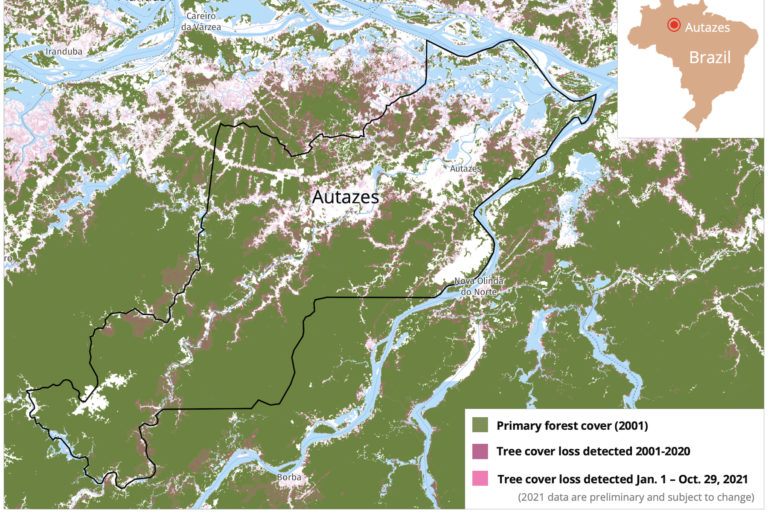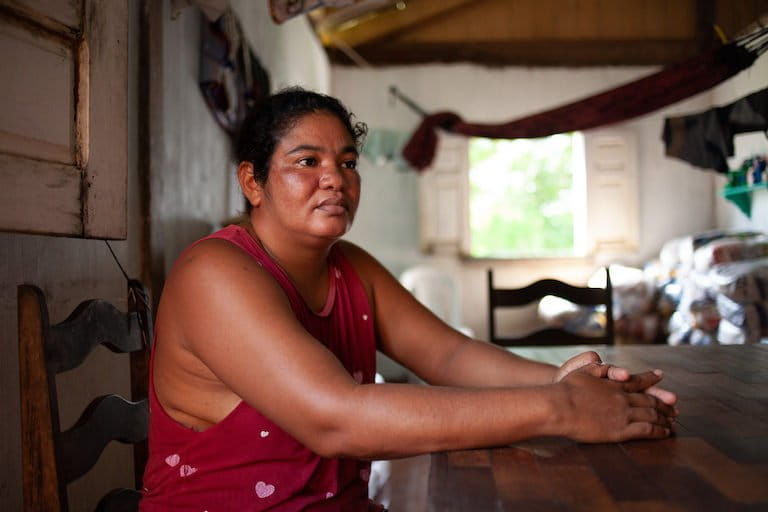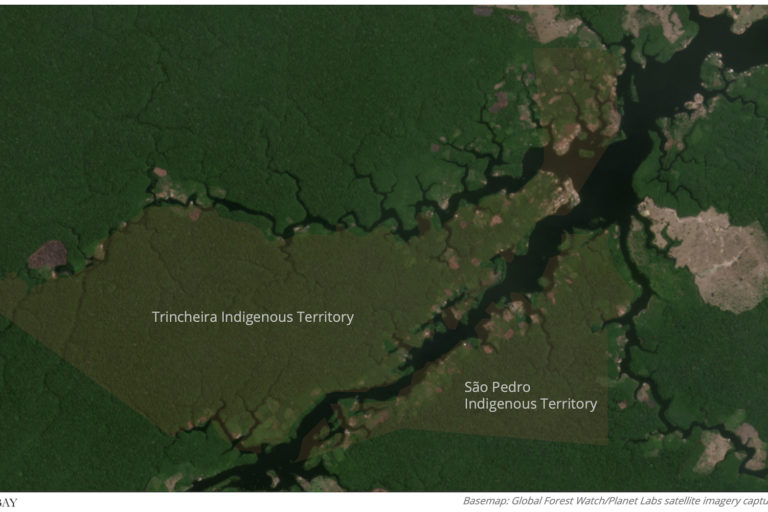Indigenous lands under siege as buffalo frenzy grips the Amazon
Nov 5, 2021
- Deforestation is rising in Autazes, a municipality in the Brazilian state of Amazonas, according to satellite data and local sources.
- Indigenous leaders say the clearing is now encroaching on the 18 Indigenous reserves that lie scattered across Autazes, some of which are still awaiting full demarcation.
- Most of the razed lots are being turned into grazing pastures for herds of domestic water buffalos, which thrive in the floodplains that characterize the region.
- Indigenous community members say that in addition to clearing forest for pasture, buffalo farming is polluting their water sources and roaming buffalos are invading communities’ subsistence farms.
TRINCHEIRA INDIGENOUS TERRITORY, Brazil — Deep in the Trincheira reserve, our motor boat winds through a maze of streams, or igarapés, sliding past dense submerged rainforest. It halts on the riverbank, in the cool shadow of the towering trees. Just meters into the jungle, though, the emerald canopy gives way to a vast stretch of felled forest and charred shrubs.
“Ever since I can remember, this forest stood untouched,” says Souza Dias Alvez, resident of the Indigenous village of Trincheira, a 15-minute journey by boat down the Preto Pantaleão river. “This here is a tragedy; it brings me deep sadness.”
This stretch of land along the Indigenous reserve’s southern edge – measuring about 20 hectares – was razed just a few months ago, he said. Alerted by Indigenous residents, federal police agents embargoed the area a few weeks before Mongabay visited in late September, prohibiting its burning. Still, the invaders returned, setting it ablaze.

In the scorching mid-morning heat, Alvez picks up a 20-kg paper sack, emptied of grass seeds and discarded amid the ashes and broken branches. “They already planted the grass. All this here will be turned into pasture, it will turn into grass to feed the buffalos.”
The Federal Police and Funai – the federal agency tasked with protecting Indigenous interests – did not respond to a request for comment.
The Trincheira Indigenous Territory spans 1,834 hectares (4,532 acres) across the municipality of Autazes, in Brazil’s Amazonas state. Here, rivers and streams crisscross the forest landscape, swelling during the rainy season to form a maze of floodplains called várzeas. Some 34 Indigenous villages dot the riverbanks, where the Mura people survive by fishing, hunting and growing subsistence crops.
But deforestation in this region is skyrocketing, as forest rapidly gives way to pasture. So far this year, more than 48,600 deforestation alerts have been confirmed in Autazes’s primary forest, according to satellite data from the University of Maryland visualized on Global Forest Watch. This represents a jump of more than 72% over the same period in 2020.

Indigenous leaders say the clearing is now encroaching on the 18 Indigenous reserves that lie scattered across Autazes, some of which are still awaiting full demarcation. Most of the razed lots are being turned into grazing pastures for herds of domestic water buffalos, which thrive in the floodplains.
This has dealt an additional blow to Indigenous people: as the animals invade the rivers and igarapés, they are polluting the water they rely on. Indigenous people warn that, as buffalo ranching closes in on their territories, the invasions are threatening the survival of the 18,000 Mura people who call this region home.
“We’re becoming an island in the middle of farms,” said Josiane Tavares dos Santos, tuxaua – or leader – of the Trincheira village. “In the future, we won’t have any more water, we won’t have any more forest, we won’t have land to plant. It’s a great loss for us.”

Buffalo frenzy
In Autazes, the markers of cattle ranching are everywhere. Towering above the town’s dusty port, a sign announces our ferry’s arrival in the “Land of Milk.” Along the riverbank, fenced livestock boats wait to take animals across the river. In the town center, huge slabs of meat hang on hooks in front of butcher shops with names like “Meek Cattle.”
The industry in Amazonas remains modest compared to neighboring Mato Grosso, Brazil’s cattle ranching heartland. But, as the cattle frenzy spills over, production is surging in places like Autazes. The municipality is home to some 80,000 head of cattle – nearly twice the number of people. Local authorities have embraced cattle ranching too, vocal about their dreams to expand output of milk, cheese and meat.

And, over the last decade, ranchers in Autazes have been placing a bet on water buffalos, which are more adaptable than conventional cattle and can provide a better return on investment. The larger animals also thrive in the region’s unique landscape of floodplain forests, where they can swim across swampy patches to find new areas to graze.
Driving through Autazes, the shift is visible. Vast green pastures flank the main road slicing through the municipality, but few cows can be spotted grazing. Mostly, herds of buffalos busily chew on shrubs, their sturdy bodies submerged in the flooded fields.
For Raimundo Aldo Gomes França, president of the Union of Rural Workers and Family Farmers of Autazes, the buffalo represents the future. França owns 185 hectares of land and 240 hectares of floodplains in a southern stretch of Autazes, not too far from the Trincheira reserve. He raises 31 buffalos on a small slice of his land and plans to expand his herd, but insists he is using sustainable methods and preserving most of his land as required by law.
“There are a lot of false accusations, demonizing the buffalo,” he told Mongabay in an interview at the union’s headquarters. “We feel these accusations too – like we’re aggressors against nature. But this expansion will happen. It’s a natural process, it’s a matter of progress.”

Yet Indigenous communities have sounded the alarm, saying their villages are being surrounded by buffalo ranches, which are wreaking social and environmental havoc. They claim that, in some cases, the ranches are even invading their territories, with the livestock destroying their subsistence crops and polluting their water.
“The buffalo is a wild animal, it doesn’t respect fences,” said dos Santos. “If you don’t have pasture for it, it will go in the water and start roaming. If it’s lacking food, it invades our farms. And we’re left struggling to feed ourselves.”
Tussle for land
The expansion of buffalo ranching has only deepened the Mura’s decades-long struggle for land rights. Once occupying vast swaths of the region’s maze of forest, floodplains and igarapés, the Mura’s territory ended up splintered into dozens of Indigenous reserves in the demarcation process – some as small as a few hectares.
“Because of this extensive region they occupied, the Mura ended up scattered, forming small villages,” said Luiza Machado from the Missionary Council for Indigenous Peoples (Cimi), an organization linked to the Catholic Church that fights for the rights of Indigenous people. “It left them less unified and more vulnerable when demarcation came.”
Farmers and ranchers soon moved into the lots between the Mura’s territories, razing the forest and transforming the land into pastures, according to Tato Mura, vice-president of the Mura Indigenous Council (CIM) and the tuxaua of the São Félix community, which lies just across the river from the town’s port.
“They came in buying up land and their holdings kept expanding,” he told Mongabay in an interview. “This is why, today, our villages are islands, surrounded by farms and pastures.”



As the Mura’s villages grew – from a handful of families to hundreds of people – it became increasingly difficult to hunt and survive off the small slices of fragmented forest that had been allocated to them. The Mura’s scattered territories are now also making them particularly vulnerable as buffalo ranching explodes around their lands, Indigenous rights activists say.
Recently, the scramble for land in Autazes has intensified on the back of plans to open a potash mine in the town, which would supply soy producers with Brazilian fertilizer. The plans have boosted speculative land sales, although the project was paralyzed after a court ruled the mining company had failed to consult the Mura people.
Federal plans to open huge stretches of the Amazon Basin to natural gas exploration have also set off land speculation, although that project has been marred by controversy as public prosecutors argue some of the blocks earmarked for exploration overlap with Indigenous territories awaiting demarcation.

Still, expectations that vast areas – including Indigenous lands – could soon be open to exploration have prompted many ranchers to sell land near the proposed project sites and seek new areas to turn into pastures, according to Indigenous leaders.
“There are a lot of ranchers coming into our territories from other places, where there is no more land,” she said. “They say they have bought this land, that they have documents. But we’ve never seen these documents.”
França acknowledged that ranchers are encroaching on Indigenous lands but rejected the idea that they are invading these reserves, blaming Indigenous residents themselves for the advance of buffalos in their territories.
“While the Indian complains to you, it was his relative that brought the rancher in there,” França said. “They sell land, they sell areas that are not theirs … They are the real bandits.”

But such land transfers are not legitimate, since Indigenous territory does not belong to any individual and cannot be legally sold, Machado said.
As agriculture closes in, some Indigenous people have in fact allowed ranchers on their lands, she said. But this only underscores the desperation gripping Indigenous villages where buffalo ranching is already threatening traditional ways of survival, Machado noted.
“The fish is running out, hunting is getting harder,” Machado said. “They can’t grow crops anymore because the buffalo next door is destroying their farms. So it’s not a matter of choice – it’s a matter of need. It’s a matter of desperation.”
Tainted waters
In the Padre Indigenous Reserve, residents are already feeling the impacts of buffalo ranching. There, the igarapé that they use to bathe, cook and fish has turned a murky brown. It is the only source of drinking water in the village. Now, residents must treat the water with drops of bleach before they can safely drink it.
“We’re almost drinking mud in our village,” said Edson de Sá Barbosa, a resident and former tuxaua of the village. “We drink it because there’s no other alternative. That’s all we have.”
Barbosa blames the three large farms surrounding their 770-hectare (1,904-acre) reserve. “They’re all raising buffalo. And it’s bringing chaos to our village. Even the common cow doesn’t contaminate and cause devastation like this.”

In the nearby village of São Félix, Indigenous people report that they regularly see buffalos, animal feces, and even electric cattle fencing in the river. Last year, a dead buffalo floated past the village school, according to Everton Mura, a teacher and the vice-tuxaua of the village.
“It was a really sad scene,” he told Mongabay in an interview near the riverbank. “Because we, as Indigenous people, as Mura people – we care deeply about the water. We watch over our water…Our river is being used as if it were a dumpster now.”
In the village of Taquara, ranchers are also invading Indigenous lands and buffalo manure has turned the water unusable. Indigenous leaders and activists report that the ranchers taunt residents and bring in ferries full of buffalos, dumping feces and straw into the river that Indigenous people use for cooking, washing and drinking.
“It’s a village that today is dominated by buffalo,” Tato Mura said. “The village is being overrun by invaders, by squatters. There is no water to drink. Today, our people are suffering the consequences.”
The Taquara community tried to block the advance of buffalo ranching in their territory through legal means, Machado said. But despite winning a motion to expel the ranchers from the territory, the deforestation has continued undeterred, she said.
The conflict between Taquara’s residents and buffalo ranchers escalated recently, when farmers assaulted and threatened the community’s tuxaua, according to Machado. The leader was forced out of the village and into a safehouse in recent weeks.
“In Taquara, the farmers are constantly testing the limits,” she said. “They keep advancing, taking one step after another. And it’s reached a critical point.”

The federal public prosecutor’s office (MPF) said in an emailed statement to Mongabay that it has opened a public inquiry into “measures adopted to guarantee access to drinking water” in Taquara, soliciting information from the federal agency for Indigenous health services and sanitation. In June, the MPF also asked the state’s Indigenous body to install a drinking well in Taquara but its request was denied, with authorities citing budget constraints, the MPF added.
The prosecutor’s office also said that, in 2018, it conducted “an extrajudicial procedure to investigate the occurrence of alleged environmental damage caused by buffalo breeding” on seven ranches in Autazes. The findings of the investigation were forwarded to the Federal Police, which did not respond to a request for comment on whether it took further action.
For dos Santos, the fear is that the Trincheira reserve is emerging as the next frontier, as buffalo ranchers descend on the territory’s lush forests. “We’re not feeling the impacts yet. But we know that, if we don’t stop these people, we will face the same fate.”

Advancing destruction
Just a few miles from the town center, a dirt road branches off the main highway that slices through Autazes. As our four-by-four vehicle snakes along the rough terrain, dense virgin jungle gives way to charred lots of razed forest. Plumes of dark smoke rise above the forest canopy. In one stretch, a fire is still engulfing a recently deforested patch of land flanking the road.
We pass by at least a half-dozen wooden barracks that local sources say likely serve as shelter for illegal loggers as they spend days in the forest, toppling century-old trees. At one point, we stumble onto a neat pile of cut timber laid next to a felled tree, ready to be transported out of the freshly-carved opening in the jungle.


The destruction lies at the doorstep of several Indigenous lands, including the Padre and Josefa/Miguel/Josefa reserves. We drive a few kilometers further, until the road abruptly halts at Sampaio Lake, where a makeshift community has sprung up and swallowed up an Indigenous village.
There are signs of a new frontier of deforestation emerging here, as invaders descend on this slice of Autazes. Indigenous leaders say the area is now plagued by illegal logging, drug trafficking and land-grabbing. Once the forest has been opened up, they say agriculture will likely follow.
“With each day that passes, the destruction expands more and more,” said Tato Mura. “They are cornering us into just a slice of land.”

Like in much of the Brazilian Amazon, invaders in Autazes have become bolder in recent years. Many have been encouraged by the rhetoric of President Jair Bolsonaro, who has pushed for the opening of protected territories to mining and agriculture, while vowing not to demarcate “another centimeter” of Indigenous land.
As their lands come under pressure, the only way to ensure the survival of the Mura culture is to create a unified Indigenous reserve, according to Tato Mura. But, with a federal government that he characterizes as “hostile to Indigenous demarcations,” the Mura are instead placing their hopes in state authorities to create a continuous territory reserved for their people.
“Today, our people are being forced to leave our villages,” Tato Mura said. “Once we reclaim our territory, we will have a way to survive on our own land.”
Banner image by Ana Ionova for Mongabay.
Editor’s note: This story was powered by Places to Watch, a Global Forest Watch (GFW) initiative designed to quickly identify concerning forest loss around the world and catalyze further investigation of these areas. Places to Watch draws on a combination of near-real-time satellite data, automated algorithms and field intelligence to identify new areas on a monthly basis. In partnership with Mongabay, GFW is supporting data-driven journalism by providing data and maps generated by Places to Watch. Mongabay maintains complete editorial independence over the stories reported using this data.
Feedback: Use this form to send a message to the editor of this post. If you want to post a public comment, you can do that at the bottom of the page.